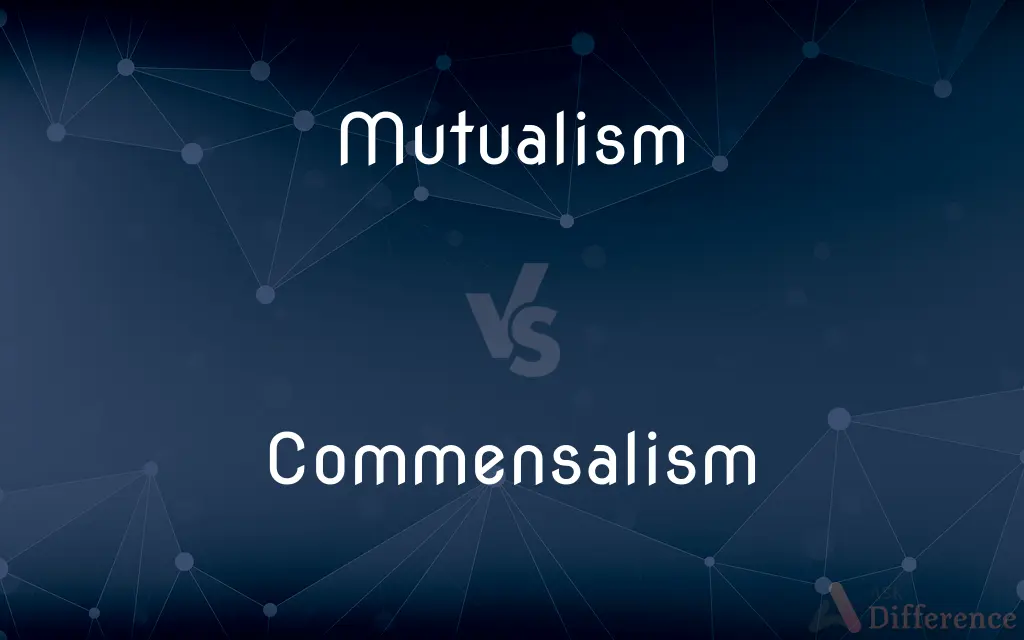Mutualism vs. Commensalism — What's the Difference?
By Maham Liaqat & Urooj Arif — Updated on April 18, 2024
Mutualism involves both species benefiting from the relationship, while commensalism benefits one without harming the other.

Difference Between Mutualism and Commensalism
Table of Contents
ADVERTISEMENT
Key Differences
Mutualism involves a relationship where both participating species gain benefits crucial for their survival or growth, such as nutrients or protection. Whereas in commensalism, one species benefits while the other neither benefits nor suffers any significant harm or advantage.
In mutualism, the interactions are often obligatory; both species rely on each other to a significant extent, like bees and flowering plants. On the other hand, commensalism involves a more casual relationship where the commensal species may not be strictly dependent on its host, such as barnacles on whales.
Examples of mutualism include the relationship between nitrogen-fixing bacteria and legumes, where both parties derive essential nutrients. In contrast, in commensalism, examples like epiphytic plants growing on trees get support without affecting the host.
Mutualism can directly influence the population dynamics and survival rates of both species involved, promoting biodiversity. Whereas commensalism primarily affects the distribution and ecological niche of the commensal organism without impacting the host species' survival.
Mutualism requires a more intricate balance and often evolves through intense co-evolutionary processes. Commensalism, however, may involve less specific interactions and can arise from opportunistic circumstances.
ADVERTISEMENT
Comparison Chart
Benefit
Both species benefit
Only one species benefits
Dependency
Often obligatory
Generally facultative
Impact on Host
Positive or necessary
Neutral
Evolutionary Relationship
Co-evolved closely
Less specific interactions
Examples
Bees and flowers
Barnacles on whales
Compare with Definitions
Mutualism
Often involves exchange of essential resources.
Mycorrhizal fungi provide minerals to plants, which supply sugars in return.
Commensalism
Affects distribution and niche adaptation of the commensal species.
Certain spiders inhabit the water trapped in bromeliad plants without affecting the host.
Mutualism
Promotes biodiversity and ecosystem stability.
Coral reefs depend on mutualistic relationships between coral and algae.
Commensalism
Often involves spatial or physical support.
Moss growing on trees uses them as a substrate without harming them.
Mutualism
A symbiotic relationship where both species benefit.
Bees pollinate flowers while collecting nectar for food.
Commensalism
Can occur as a byproduct of another activity.
Birds nesting in trees disturb insects, which are eaten by the birds.
Mutualism
Can be obligatory, meaning both species are interdependent.
Lichens are formed from fungi and algae that cannot survive separately.
Commensalism
Typically does not involve direct exchanges.
Epiphytic orchids use tree branches for support without affecting the trees.
Mutualism
Interaction that enhances survival or reproduction for both parties.
The clownfish and anemone protect each other from predators.
Commensalism
A relationship where one organism benefits and the other is unaffected.
Remoras hitch a ride on sharks and feed on leftovers.
Mutualism
An association between two organisms of different species in which each member benefits.
Commensalism
Commensalism is a long-term biological interaction (symbiosis) in which members of one species gain benefits while those of the other species neither benefit nor are harmed. This is in contrast with mutualism, in which both organisms benefit from each other; amensalism, where one is harmed while the other is unaffected; parasitism, where one is harmed and the other benefits, and parasitoidism, which is similar to parasitism but the parasitoid has a free-living state and instead of just harming its host it eventually ends up killing it.
Mutualism
(ecology) Any interaction between two species that benefits both; typically involves the exchange of substances or services.
Commensalism
A symbiotic relationship between two organisms of different species in which one derives some benefit while the other is unaffected.
Mutualism
An economic theory and anarchist school of thought that advocates a society where each person might possess a means of production, either individually or collectively, with trade representing equivalent amounts of labor in the free market.
Commensalism
(ecology) A sharing of the same environment by two organisms where one species benefits and the other is unaffected. An example is barnacles on whales.
Mutualism
The doctrine of mutual dependence as the condition of individual and social welfare.
Commensalism
The act of eating together; table fellowship.
Mutualism
The relation between two different species of organisms that are interdependent; each gains benefits from the other
Commensalism
The act of eating together; table fellowship.
Commensalism
The relation between two different kinds of organisms when one receives benefits from the other without damaging it
Common Curiosities
What are the ecological impacts of mutualism?
Mutualism can increase biodiversity and ecosystem resilience by establishing interdependent relationships that enhance the survival of multiple species.
Can a mutualistic relationship exist without direct contact between the two species?
Yes, some mutualistic relationships involve indirect interactions, like the dispersal of plant seeds by animals that consume the fruit.
What is an example of mutualism in deserts?
The relationship between ants and desert plants where ants protect plants from herbivores and in return receive shelter or food.
What role does genetic diversity play in mutualism?
Greater genetic diversity within each species can enhance the resilience and adaptability of mutualistic relationships.
How do scientists study commensal relationships?
Researchers study commensal relationships by observing interactions in natural habitats or controlled experiments to identify benefits received by one species without impacting the other.
What factors can disrupt a mutualistic relationship?
Environmental changes, loss of habitat, and introduction of invasive species can disrupt mutualistic relationships.
What is the economic importance of mutualistic relationships?
Many mutualistic relationships, such as those involving pollinators and crops, are crucial for agriculture and food production.
How does commensalism differ from parasitism?
In commensalism, one species benefits without affecting the other, while in parasitism, one species benefits at the expense of the other.
How prevalent is commensalism in urban environments?
Quite prevalent; for example, birds or rodents living in urban areas may use human structures for shelter without affecting the humans.
Are there mutualistic relationships that involve more than two species?
Yes, complex mutualistic networks can involve multiple species, all interdependent in intricate ways, such as pollinators interacting with various plants.
What is an unusual example of commensalism?
Spiders building webs on artificial structures like lamp posts, which provide a platform for catching prey without affecting the structure.
Can mutualism lead to coevolution between species?
Yes, mutualism often drives coevolution as each species adapts to enhance the mutual benefits of the relationship.
How does climate change affect commensal relationships?
Climate change can alter habitats and resources, potentially turning neutral commensal relationships into competitive or even parasitic ones.
How do human activities impact mutualistic relationships?
Pollution, habitat destruction, and climate change can disrupt or destroy mutualistic relationships, affecting entire ecosystems.
What are some conservation strategies for protecting mutualistic relationships?
Strategies include preserving natural habitats, restoring ecological balance, and promoting biodiversity to support and sustain mutualistic interactions.
Share Your Discovery

Previous Comparison
Adolescent vs. Teenager
Next Comparison
Teleological vs. DeontologicalAuthor Spotlight
Written by
Maham LiaqatCo-written by
Urooj ArifUrooj is a skilled content writer at Ask Difference, known for her exceptional ability to simplify complex topics into engaging and informative content. With a passion for research and a flair for clear, concise writing, she consistently delivers articles that resonate with our diverse audience.
















































